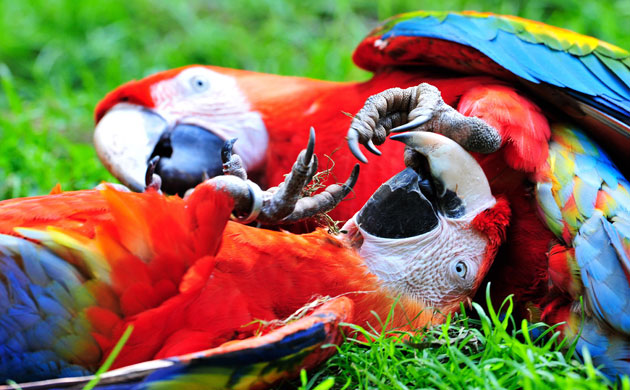TOP STORIES Energetic Bottleneck Factors In Catastrophic Winter Seabird Losses
Energetic Bottleneck Factors In Catastrophic Winter Seabird Losses
Science Daily - www.sciencedaily.com
17 Jul 2009
It's a terrible sight: hundreds of dead seabirds washed up on the seashore. These catastrophic events occur in the winter and are known as winter wrecks. No one knows why the birds perish, and it is almost impossible to study the animals out in stormy winter seas to find out how they meet their fate.
With the birds' tough life style in mind, Jérôme Fort and David Grémillet from the CNRS Centre d'Ecologie Fonctionnelle et Evolutive in France decided to try to estimate the energetic demands placed on two alcid species (little auks and Brünnich's guillemots) by their aquatic lifestyle to find out whether battling the harsh conditions may simply be too energetically demanding for the little seafarers. Fort and his colleagues publish their discovery that winter wreck victims may not be able to eat enough to survive the harsh winter conditions in the Journal of Experimental Biology.
Greater Yellowstone Elk-wolf Study Shows Elk Having Fewer Calves Due To Changes In Nutrition
Science Daily - www.sciencedaily.com
17 Jul 2009
Wolves have caused elk in the Greater Yellowstone Ecosystem to change their behavior and foraging habits so much so that herds are having fewer calves, mainly due to changes in their nutrition, according to a new study published by Montana State University researchers.
During winter, nearly all elk in the Greater Yellowstone Ecosystem are losing weight, said Scott Creel, ecology professor at MSU, and lead author on the study which appears in the Proceedings of the National Academy of Sciences.
"Essentially, they are slowly starving," Creel said. "Despite grazing and browsing during the winter, elk suffer a net loss of weight. If winter continued, they would all die, because dormant plants provide limited protein and energy, and snow makes it more difficult to graze efficiently."
 Bee Colony Collapse Disorder: New Bait Lures Varroa Mite To Its Doom
Bee Colony Collapse Disorder: New Bait Lures Varroa Mite To Its DoomScience Daily - www.sciencedaily.com
15 Jul 2009
Varroa mites could literally be walking into a trap—thanks to a new attractant developed by Agricultural Research Service (ARS) scientists in Gainesville, Fla.
The 1/16-inch long parasite, Varroa destructor, is a top pest of honey bees nationwide, hindering the beneficial insects' ability to pollinate almonds, blueberries, apples, zucchini and many other flowering crops.
At the ARS Chemistry Research Unit in Gainesville, research leader Peter Teal and colleagues are testing a bait-and-kill approach using sticky boards and natural chemical attractants called semiochemicals.
 Invasive Species Threaten Critical Habitats, Oyster Among Victims
Invasive Species Threaten Critical Habitats, Oyster Among VictimsScience Daily - www.sciencedaily.com
17 Jul 2009
Location: California, USA
A study of oyster reefs in a once-pristine California coastal estuary found them devastated by invasive Atlantic Coast crabs and snails, providing new evidence of the consequences when human activities move species beyond their natural borders.
Led by marine biologist David L. Kimbro, now of The Florida State University Coastal and Marine Laboratory , the study shows that in Tomales Bay , half the population of California's native Olympia oyster has perished because its habitat has fallen victim to the dysfunctional relationship between native species and non-native ones accidentally introduced.
TOP READ LINKS FROM LAST WEEK
- Avian Zoonotic Diseases: Work Smart, Stay Safe [video presentation]
- Zoonotic Diseases (Mammalian): Work Smart, Stay Safe [video presentation]
- DEP: 90% of Hibernia Mine's bats are dead
- Vets learn how to track disease
- Disease runs riot as species disappear
- Webinar Presentation on White-Nosed Syndrome [video presentation]
- Senate hearing focuses on threats to wildlife
- Bird Population Declines In Northern Europe Explained By Thiamine (vitamin B1) Deficiency
- Mutant fish spawn cry for chemical ban
- Subcommittee on Water and Wildlife and Subcommittee on Oversight joint hearing entitled, “Threats to Native Wildlife Species” [webcast]
- Applying the Theory of Island Biogeography to Emerging Pathogens: Toward Predicting the Sources of Future Emerging Zoonotic and Vector-Borne Diseases
- Wild birds of declining European species are dying from a thiamine deficiency syndrome
- Journal of Zoo and Wildlife Medicine [Table of Contents]
OTHER WILDLIFE RELATED NEWS
Photo courtesy of The Guardian

- Week in Wildlife [photo gallery]
- Bovine brucellosis - Fiji - positive. serology, official [Viti Levu, Fiji - Map It
 ]
] - Sea Otter Funding Dries Up, Needs $40K
- Don't Blame Birds for 1918 Flu
- Lyme disease cases rise as West Nile virus falls
- Deadly disease infects fish; Barron County remains okay [Wisconsin, USA]
- NY investigates river's fish die-off [New York, USA - Map It
 ]
] - Concerns over Fish Virus in Oakland Co. [Michigan, USA]
- Maine firm to contribute research on bat syndrome
- Bat-killing disease remains a mystery
- Radar beams could protect bats from wind turbines




